Other Connections
Outside the Baltic Sea and the Strait of Messina, sea-going passenger train ferries always were rare. In some cases, ferries which carried goods wagons, equipment or special trains, have been confused with regular passenger train ferries. One Canadian train ferry came even to Europe. It was the 3,365-ton "Leonard" of the Canadian National Railway, completed in 1915 for the Quebec - Levis passage across the St. Lawrence River (described by P. Ransome-Wallis). After on 12 December 1917 a bridge was opened there, the ferry was relocated to the Southampton - Cherbourg military service. From New Zealand the transport of tourist specials across the Cook Strait is reported, but it was not a train ferry conveying regular passenger trains. Nevertheless some rail ferries should be mentioned, though they had been either no deep-sea or no passenger train ferries.
Egypt
Only a few years after world's first passenger train ferry was inaugurated in Great Britain, a train ferry started to cross the Nile. As the British Prime Minister Lord Palmerston was not a friend of the French Suez Canal project, Sir John Pirrie of the P&O asked the ruler Abbas I Pasha for licensing a railway from Alexandria to Suez, proposed already by the pioneer Thomas F. Waghorn, thus accelerating the Indian Mail. The standard gauge line, realized under guidance of Georges Stephenson, reached the Nile in 1854 and Cairo in 1856. Initially the Nile had to be crossed at Benha and at Kafr el Zaiat by ferry, described as a single-track pontoon-type vessel, 24.38m long and 18.29m wide, the center being elevated by winches (see Lionel Wiener: L'Egypte et ses chemins de fer). A tragic accident happened in 1856 when a Royal special train with the sons of ruler Mehemet Ali plunged into the Nile and Prince Halim died while his brother Ahmed stayed alive.
United States
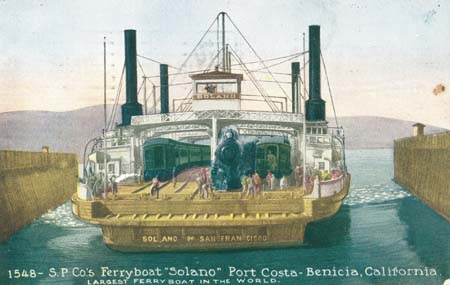 "Solano" on the Carquinez Strait (old card, coll. WS)
"Solano" on the Carquinez Strait (old card, coll. WS)
Among the very important train ferries operating on rivers was the "H.C.McComb", which conveyed between 1873 and 1889 the expresses Chicago - New Orleans across the Ohio River. There were various train ferries on rivers and sounds, mainly for freight. The famous Overland Limited and other expresses Chicago - San Francisco were ferried across the Carquinez Strait between Benicia and Port Costa before they reached the Oakland Mole, where travelers took a passenger ferry to the pier at San Francisco's Market Street. Southern Pacific's train ferry "Solano" of the Carquinez Strait service was described as the largest ferry boat of the world. In 1929 the ferries of the Carquinez Strait were replaced by a bridge.
Balkan
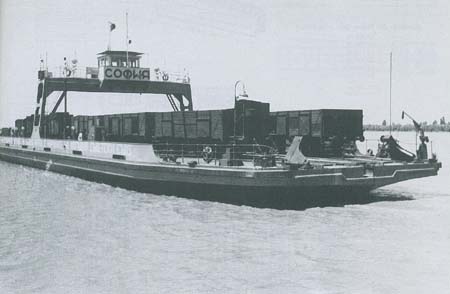
"Sofia" Ruse - Giurgiu (P. Wassilew/ coll. Dejanow/ Slezak)
|
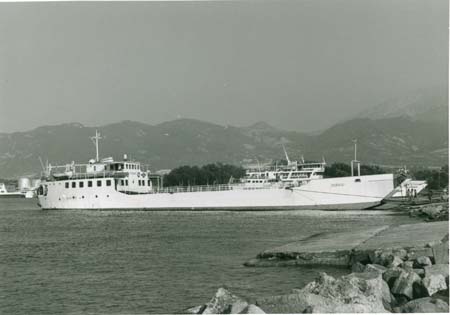
"Rodos", car ferry with rail track, at Rion, Gulf of Patras, 1978 (WS)
|
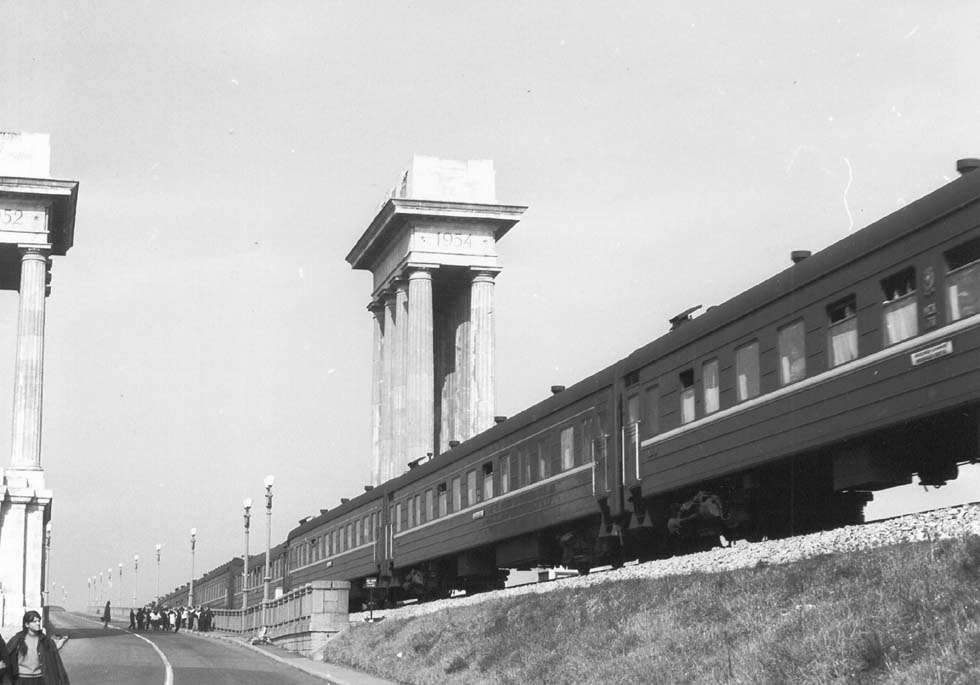
Dunav-Express Moscow - Sofia, crossing the Danube bridge near Ruse, 1970 (WS)
When in 1883 the first connection Paris - Istanbul was introduced with the famous Orient-Express, passengers had to board a steamboat at Giurgiu in Romania for crossing the Danube. As the direct rail track Serbia - Turkey was completed in 1888, a Danube train ferry at Giurgiu has not been urgent. Only in 1940 a train ferry connection Giurgiu - Ruse was established with the pontoon type 3-track "Sofia" of 920 gt, built in Walsum, Germany. It got a special significance when, after Tito's disagreement with Stalin, the Balt-Orient-Express (ferried already across the Baltic Sea) took this way to Sofia, listed with the timetable conference for 1951 in combination with the Moscow - Sofia connection. In 1954 the ferry was replaced by a gigantic bridge, used by the new sleeping-car service Moscow - Sofia. During WWII also another Danube ferry had been introduced for German military purposes at Calafat. Like the train ferries between Varna, Bulgaria, and Ilyichovsk near Odessa, introduced in 1978, it has not been employed in conveying passenger trains regularly. An almost unknown sort of train ferry could have been watched decades ago crossing the Gulf of Patras in Greece. It was a little truck ferry, equipped with a rail track for conveying rolling stock.
Turkey
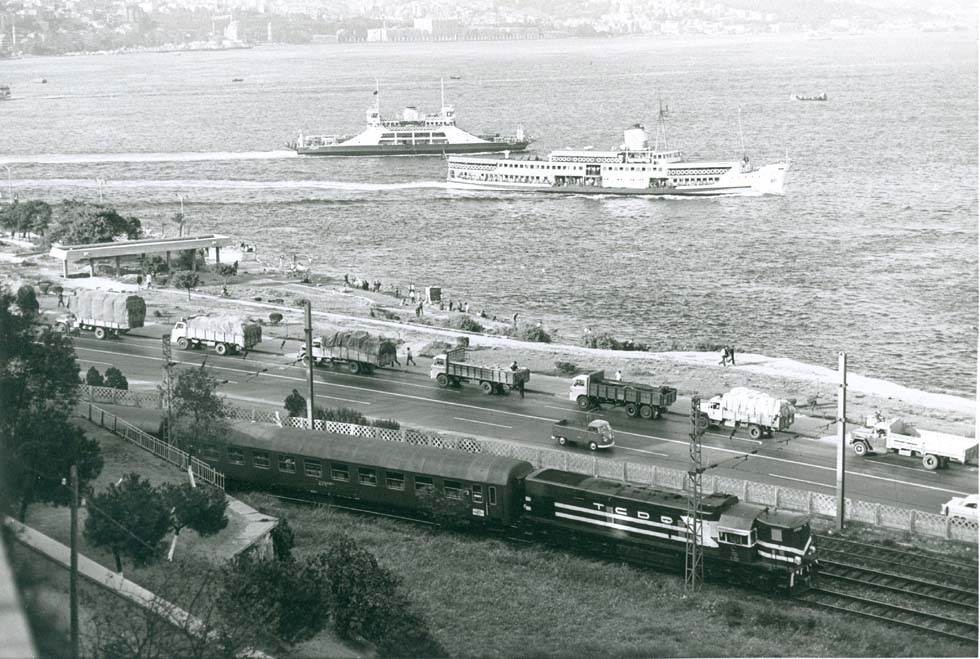
Bosporus car ferry, passenger ferry and Istanbul-Express for Frankfurt, 1972 (WS)
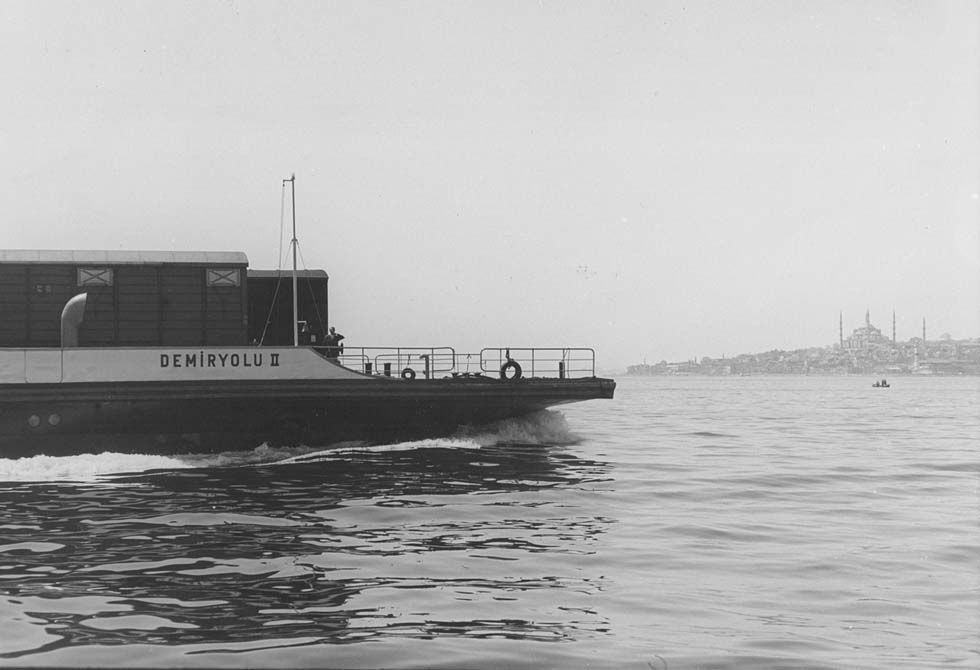
Train ferry "Demiryolu II", Istanbul 1971 (WS)
The Bosporus separates the European from the Mideast railway network. A tunnel was mooted already in 1860, but it was delayed for one and a half century. When CIWL started the Anatolie-Express Istanbul Haidarpasa - Ankara in 1927, they chartered a local passenger ferry for a fast service connecting the railway stations Sirkeci and Haidarpasa. The European Timetable Conference for 1931 disputed a future extension of the Simplon-Orient-Express to Baghdad, ferried across the Bosporus. Even the dream "London - Cairo" emerged, a combination of Night Ferry and Simplon-Orient-Express. However, the first train ferry crossing the Bosporus was introduced by the Turkish railways TCDD not before 1958. It was the "Demiryolu" of 1,316 tons, followed by the "Demiryolu II" and other ones, exclusively for cargo. The Nostalgic Istanbul Orient Express of Alby Glatt should have made a special trip to Baghdad in 1978, using the Bosporus train ferry, but Mideast hostilities prevented it. Finally, modern Turkey started building the Bosporus tunnel for completion in 2012. It's a tunnel for high-speed trains, which have revolutionized already Turkey's rail traffic.
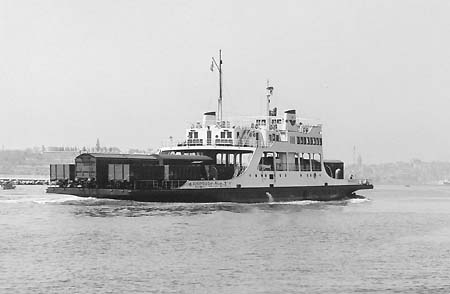
"Demiryolu II", Istanbul 1971 (WS)
|
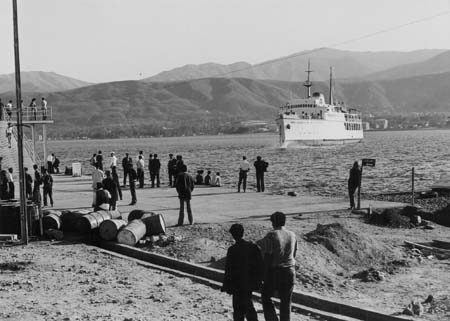
"Orhan Altiman" arriving at Tatvan pier, 1973 (WS)
|
When Iran under the Shah had been a member of CENTO, building a strategic rail link Turkey - Iran has been decided. By economic reasons the Lake Van in eastern Turkey had to be crossed by train ferry. In 1971 the line was opened and soon cars of the Vangolu Ekspresi Istanbul - Tehran were ferried from Tatvan pier to Van by the "Refet Unal" and the "Orhan Altiman". After Khomeini's revolution, passenger trains Turkey - Iran were stopped towards 1981. Conveyance at least of vans was resumed in 2000 by Turkish Maritime Lines, then TDI. Indeed the voyage across the Lake Van in an altitude of 1,600 m over a distance of 43 nm aboard the "Refet Unal", amidst Turkish, Iranian, even Indian passengers and European backpackers during the "hippie" years has been a unique experience, when the setting sun disappeared behind a 4,100 m high volcano in the west and the ship headed into the eastern night...
Trans-Siberian
When the Trans-Siberian railway was built, Lake Baikal initially had to be crossed by boat and in winter by sleigh. In 1900 the state-owned icebreaker train ferry "Baikal" of 4,200 tons was completed at Irkutsk under supervision by Armstrong, followed by the smaller icebreaker "Angara". The "Baikal" could convey 25 cargo wagons from Baikal port to Misovaya, but she did not ferry passenger trains. The "Angara", suitable for passenger transport, obviously was never a train ferry. The railway along the southern shore of the lake was ready right in time for the Russo-Japanese war, but regular traffic started not before 1906. In the meantime, passengers had to use the "Angara" between Baikal and Misovaya and Amur river boats between Sretensk and Khabarovsk until c. 1906 or 07, when the Transsiberian Express could pass to Vladivostok via Manchuria. The "Baikal" was sunk during the Civil War in 1920 and her wreck is reported laying somewhere close to Misovaya. The two-funnel "Angara" has been preserved as a historic monument.
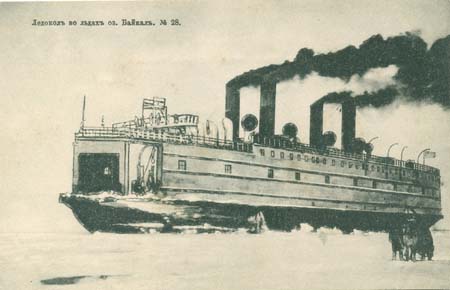 "Baikal" before WWI (old card, coll. WS)
"Baikal" before WWI (old card, coll. WS)
USSR, Russia
In the years of the Soviets' rule over Eastern Europe, a surprising vision was published by the Soviet daily "Pravda" in 1971. A new harbour should have been built near Cuxhaven on the German North Sea coast, connected by a Russian broad-gauge railway. More realistic was the Soviets' proposal of a rail ferry from Klaipeda, Lithuania, to Kiel in Germany for Russian broad-gauge cargo trains. It was rejected, for Kiel is a German naval base. Finally a ferry terminal was completed at Mukran on Ruegen Island in East Germany (GDR) in 1986, connected with Klaipeda, the former Memel, by rail-ferries exclusively for cargo. Five ships were to be commissioned, two under Russian and three under German flag. With two train decks they were the biggest train ferries of the world. Even after the German reunification in 1990, Russian soldiers guarded still for some time the port and the ferries, which had a reduced service. Arnold Kludas listed the vessels "Mukran", "Vilnyus", "Greifswald" and "Kaunas" of c. 22,000 tons each, later rebuilt for carrying also trucks and passengers. The "Mukran", renamed "Petersburg", and the "Greifswald" changed to Deutsche Seereederei and the "Vilnius" as well as "Kaunas" to LISCO, then to Latlines and DFDS TorLine. Later, Cooks European Timetable listed DFDS LISCO. In 2007 the Railion group took up ro-ro services from Sassnitz-Mukran to Baltiysk (the former Pillau) in the Russian Oblast Kaliningrad with the "Vilnius". Like the train ferries of the Black Sea and the Caspian Sea, all these ships do not convey passenger trains.
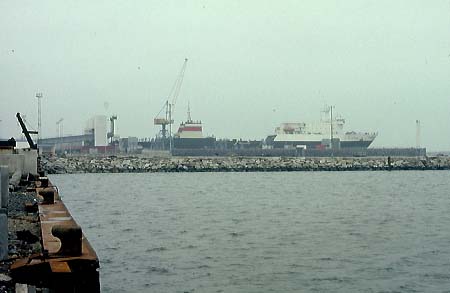
"Mukran", the later "St. Petersburg", at Neu-Mukran 1991 (WS)
|
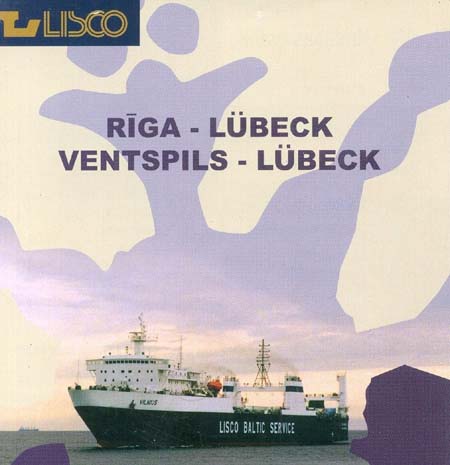
"Vilnius", LISCO ad 2005
|
Sakhalin Island in the Far East (see chapter Ferries/ Japan Sea) got a railway-owned train ferry connecting the mainland. From 1973 the 5,025-ton icebreaker-ferries "Sakhalin-1" to "Sakhalin-5" were delivered from Kaliningrad yard, taking 72 passengers and, stern-loading, up to 26 wagons for the voyage of c.150 miles from Vanino across the Tatars Sound to Materiki and Kholms on Sakhalin. More vessels were added by SASCO. Regular passenger trains are not ferried. Contrary to the Trans-Siberian, the rail network on the island was built in Cape gauge, inherited from the early Japanese track. Now an express train even with sleeping-cars is running from Nogliki in the north to Yuzhno Sakhalinsk in the south.
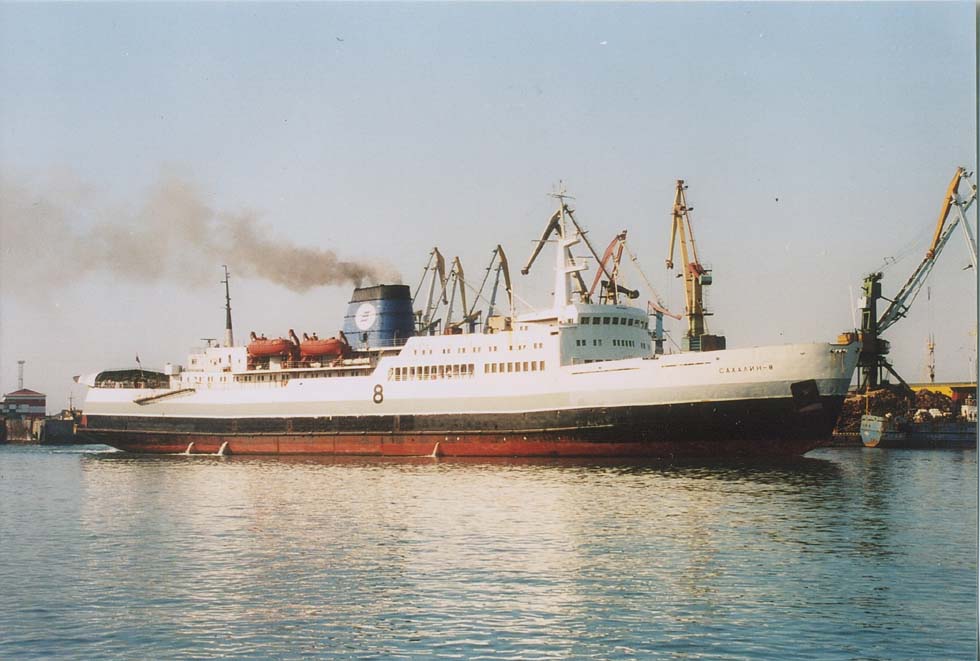
"Sakhalin-8" at Kholmsk, Sakhalin 2008 (Heiko Mueller)
Japan
Passengers of the Trans-Siberian expresses reached Japan by ship, never by a train ferry. Within Japan, the first step towards the carriage of wagons was undertaken in 1911, when the Kanshin N.R. began operations from Shimonoseki to Kumorie on Kyushu with an unpowered barge being towed by a steam tug. In 1914 a similar service was taken up by the Seikan N.R. between Aomori and Hakodate on Hokkaido island in the north. In 1924 the first true ferry, the "Shoho Maru", was introduced on that route. Like her successors and generally the Japanese train ferries, she carried goods wagons and passengers, but no regular passenger trains - see also chapter Branch Lines & Ferries/ Japan Sea. In the 60s new diesel-powered 8,300-ton ships were introduced. Opening of the Seikan Undersea Tunnel in 1988 meant the end of the Seikan Renrakusen services. As a remembrance, one of the modern ferries, the "Mashu Maru" of 1965, became a museum ship at Hakodate.
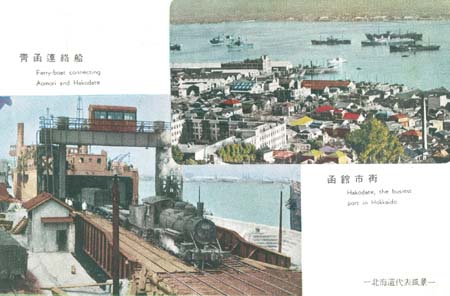
Shoho Maru class (?) and the port of Hakodate (old card, coll. WS)
|
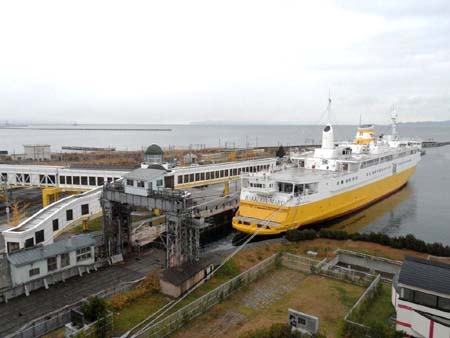
"Hakkoda Maru" of the 60s, Aomari 2010 (Heiko Mueller)
|
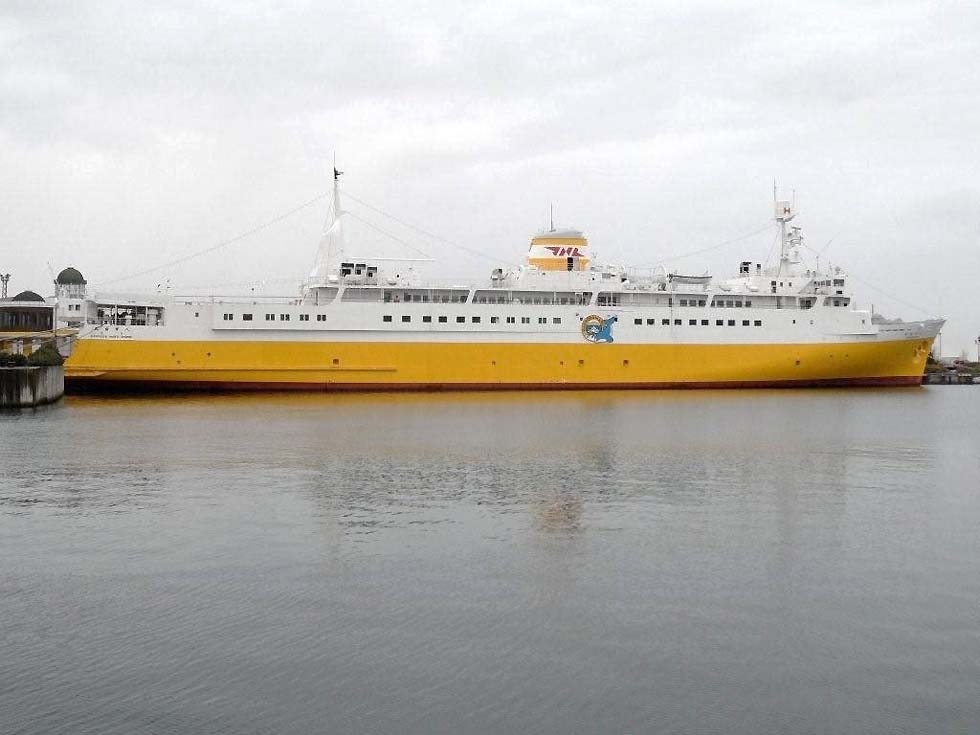
"Hakkoda Maru" at Aomari, 2010 (Heiko Mueller)
China
In the north, between Yantai and Lushun near Dalian, Zhong Tie Bo Hai (also described as Sinorail Bohai) opened in 2006 a freight train ferry service with the "Zhong Tie Bo Hai 1 Hao", followed by no.2 and the larger 3. The ferries convey also trucks and for passengers they are equipped even with supermarket and cinema. A 23km long rail track has been built at Lushun, the former Port Arthur.
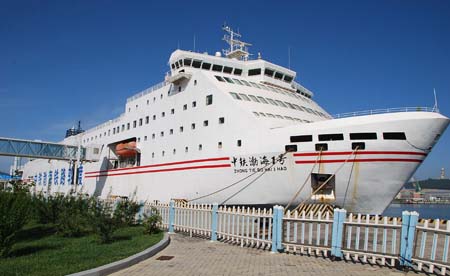
"Zhong Tie Bo Hai I Hao" at Lushun (Yoshi Canopos, via Wikimedia)
|
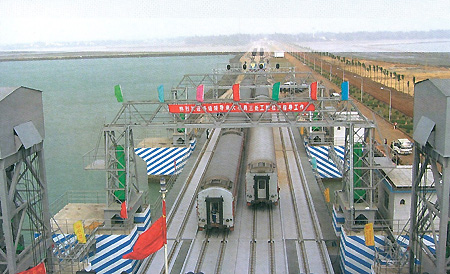
Hainan Ferry at North Port (official photo)
|
Hainan Island in the south of China, close to Vietnam, now a destination for tourists, was once a place of strategic importance. Not a single hint at the ferry service to the island or the existing Hainan railway has been published by international timetables. Nevertheless a ferry between the North Port near Haikou and a ferry port near Xucheng (Xuwen) on the mainland has been inaugurated in winter 2002/03, built by the China Railway Import & Export Co. together with Bosch Rexroth of Germany, responsible for the advanced taiphoon-proof steering system. Kludas listed the "Yue Hai Tie 1 Hao" (14,381 gt) and her sister, conveying passengers, motorcars and wagons. In 2008 Thomas Cook Overseas Timetable mentioned a passenger train from Beijing to Sanya, the tourist resort in the south of Hainan Island (at present more information is not available).
Argentina - Paraguay
On the way from Buenos Aires to Paraguay, the railway reached the small town of Posadas in the north of Argentina in 1910. After c. 180 km, near Zarate, the Rio Parana had to be crossed by a train ferry, until in 1978 a bridge was completed. At Posadas, 1,182 km distant from Buenos Aires, the Parana was traversed once again by a train ferry, inaugurated in 1913. An international express connected the capitals Asuncion and Buenos Aires still in the '80s. Railway historians Roy Christian and Ken Mills described a journey:"... the train heads toward the river down the length of a Encarnacion street before rolling downhill via a switchback to the ferry terminal at Pacu Cua. Here the coaches are lowered singly down an incline with a steam-operated winch and cable onto the two-track ferryboat". In 1989 the Parana suspension bridge for rail and road traffic was opened, a sparkling miracle of our time - but the international express disappeared soon.
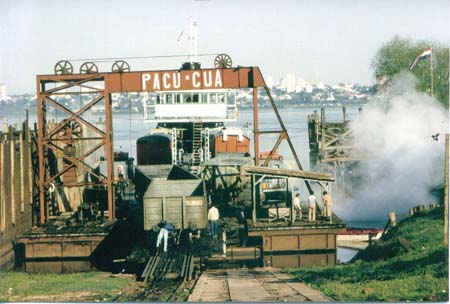 Pacu Cua ferry terminal, 1987 (Guenter Haslbeck)
Pacu Cua ferry terminal, 1987 (Guenter Haslbeck)
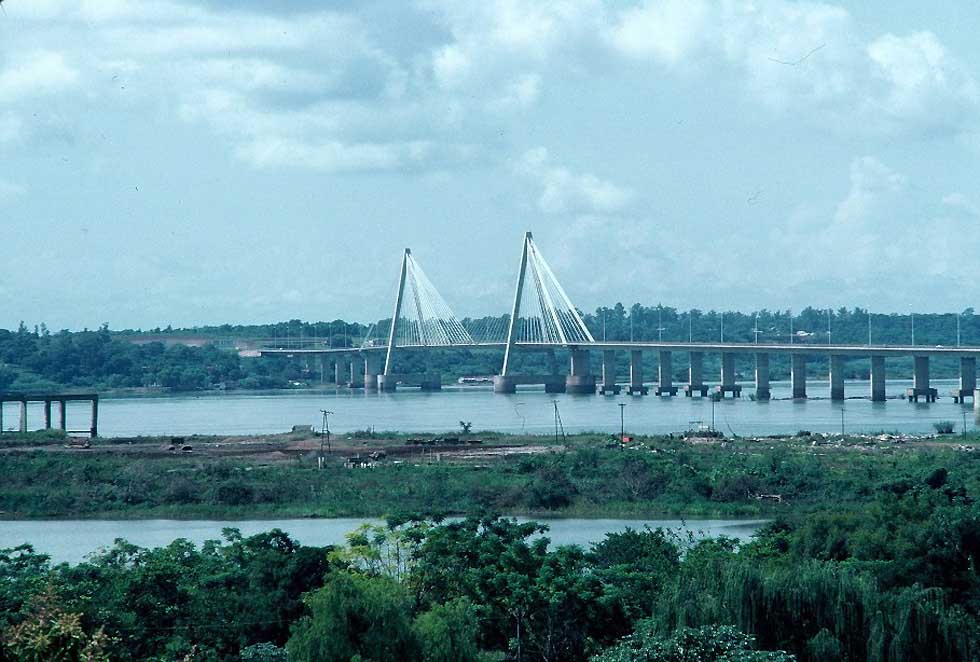
Parana bridge near Posadas, 1993 (WS)

|

|
|
|